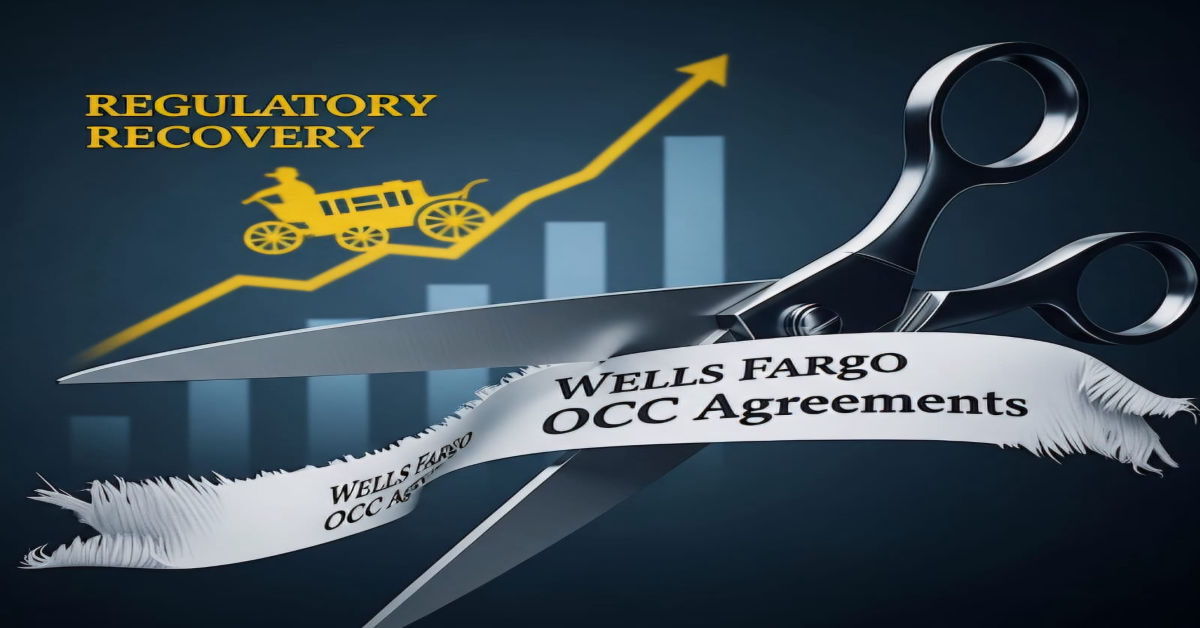In recent years, Wells Fargo has been under intense regulatory scrutiny due to a series of high-profile compliance failures including the creation of unauthorized customer accounts and broader governance issues. These lapses triggered multiple investigations and enforcement actions by U.S. regulators, damaging the bank’s reputation and leading to strict oversight by federal agencies. One of the most critical of these was a set of 2015 consent agreements with the Office of the Comptroller of the Currency (OCC), which required Wells Fargo OCC Agreements Termination to implement substantial changes to its internal controls, risk management practices, and overall compliance structure.
A major development in 2025 is the termination of those 2015 OCC agreements, signaling a significant step forward in Wells Fargo’s ongoing recovery and reform efforts. This resolution suggests that the bank has made meaningful progress in addressing the shortcomings identified by regulators and is now on a path toward restoring trust with customers, investors, and oversight bodies. While challenges remain, the lifting of these regulatory restrictions reflects a broader pattern of compliance improvements and is viewed as a key milestone in Wells Fargo’s efforts to rebuild its credibility and operational integrity in the financial sector.
Understanding OCC Agreements
The OCC, a key federal bank regulator, enforces laws that promote the safety and soundness of the national banking system. OCC agreements are formal orders that mandate specific corrective actions by banks. These agreements often follow regulatory findings that expose gaps in risk management, compliance, or operations. They remain in effect until the OCC is satisfied that the necessary improvements have been made.
Wells Fargo’s Regulatory History
Wells Fargo has dealt with multiple consent orders and regulatory penalties since 2016. These stemmed from scandals involving customer account manipulation, sales practices misconduct, and other control failures. Since 2019, the company has resolved thirteen consent orders. This track record indicates a continued effort toward restoring regulatory trust and strengthening operational integrity.
The 2015 OCC Agreements Explained
The 2015 OCC agreements related specifically to Wells Fargo’s former financial subsidiaries. These entities were involved in various activities that required oversight improvements. The agreements required the implementation of stronger internal controls, enhanced monitoring of financial practices, and better risk governance. Their recent termination confirms that the OCC now considers these issues resolved.
What Led to the Termination of the 2015 Agreements
The termination was a result of prolonged remediation efforts undertaken by Wells Fargo. These included:
- Overhauling internal auditing procedures
- Streamlining operational controls across subsidiaries
- Rebuilding compliance frameworks from the ground up
- Independent third-party reviews
- Strengthening leadership accountability
The OCC determined that the bank’s current practices no longer posed the regulatory concerns initially identified.
Timeline of Consent Order Terminations
The following table highlights the progression of terminated consent orders since 2019:
| Year | Consent Orders Terminated | Key Focus Areas |
| 2019 | 2 | Sales Practices, Compliance Culture |
| 2020 | 3 | Operational Risk, Internal Controls |
| 2021 | 1 | Risk Governance |
| 2022 | 1 | Data Management Practices |
| 2023 | 3 | AML Programs, Cybersecurity |
| 2024 | 2 | Financial Subsidiary Oversight |
| 2025 | 1 | 2015 OCC Agreements |
Impact on Wells Fargo’s Business Operations
The conclusion of these agreements enables Wells Fargo to shift its focus toward business expansion and innovation. Some of the potential positive impacts include:
- Greater investor confidence
- Reduced regulatory capital expenses
- Flexibility in launching new financial products
- Improved brand reputation
Moreover, Wells Fargo may now consider new acquisitions or partnerships previously restricted by regulatory conditions.
OCC’s Perspective on the Termination
According to the OCC, the decision to terminate the 2015 agreements was based on demonstrated improvements in risk management and compliance. The regulator acknowledged that the bank now operates with improved safety and soundness standards. Such endorsements indicate that regulators see Wells Fargo as having made substantial progress in rebuilding its internal structures.
The Last Remaining Consent Order: Federal Reserve
Despite this positive momentum, Wells Fargo still operates under a 2018 consent order issued by the Federal Reserve Board. This order requires:
- Further strengthening of board oversight
- Controls for risk management
- Improvement of compliance risk frameworks
The resolution of this remaining order will be key to Wells Fargo’s complete regulatory reset.
Implications for Financial Compliance
Terminating a consent order does not just remove a regulatory burden. It also sends a strong message about a company’s operational maturity. In Wells Fargo’s case, it reflects a transformation in:
- Employee training programs
- Internal compliance monitoring
- Fraud detection capabilities
- Executive-level accountability
This serves as a model for other banks navigating similar challenges.
Anti-Money Laundering Controls and Risk Management
The OCC also terminated a formal agreement with Wells Fargo Bank, N.A., tied to its anti-money laundering (AML) and financial crime risk practices. Key enhancements included:
- Advanced transaction monitoring systems
- Real-time fraud alerts
- Enhanced due diligence for high-risk clients
- Automated suspicious activity reporting
These reforms position the bank to meet future regulatory demands more effectively.
Significance of Terminating the Graham-Leach-Bliley Act Agreements
Two agreements under the Graham-Leach-Bliley Act were also terminated. These were related to:
- Data privacy controls
- Customer information security
The termination reflects significant progress in technology governance and data protection. In today’s landscape, where cyber threats are evolving, strong adherence to these regulations is non-negotiable.
Investor and Market Reactions
Wells Fargo’s stock experienced a notable rise following the announcement. Market analysts view the development as a sign of operational stability. Shareholders have expressed optimism regarding:
- Reduced regulatory costs
- Improved earnings projections
- Potential dividend increases
- Enhanced stockholder value
This momentum could influence long-term investor confidence and stock performance.
Future Regulatory Challenges for Wells Fargo
While the termination of these agreements marks progress, the journey isn’t over. Key challenges remain, including:
- Full resolution of the Federal Reserve consent order
- Continuous adaptation to emerging compliance risks
- Navigating digital transformation without compromising security
- Strengthening ethical culture at all organizational levels
These areas will require ongoing investment and commitment.
Lessons Learned for the Banking Sector
Wells Fargo’s regulatory evolution offers several takeaways for other financial institutions:
- Proactive engagement with regulators accelerates resolution.
- Organizational transparency builds trust.
- Investing in technology-driven compliance pays off long-term.
- Leadership stability is critical during recovery periods.
- Remediation must be embedded in the culture, not treated as a checklist.
These lessons serve as a blueprint for banks facing regulatory scrutiny.
Final Thoughts and Conclusion
The termination of the 2015 OCC agreements is more than just a regulatory technicality. It symbolizes a key milestone in Wells Fargo’s transformation and a hopeful sign of accountability and renewal. While challenges remain, particularly with the Federal Reserve’s outstanding order, the overall trajectory appears promising. Stakeholders—customers, investors, and regulators—will now look for consistency in performance and compliance across all aspects of Wells Fargo OCC Agreements Termination.
Frequently Asked Questions (FAQs)
What are OCC agreements?
These are formal regulatory agreements that require banks to take corrective actions to address identified deficiencies.
Why were the 2015 OCC agreements significant?
They addressed compliance and oversight issues within Wells Fargo’s financial subsidiaries, making them a central part of the bank’s regulatory reform efforts.
How many consent orders has Wells Fargo OCC Agreements Termination since 2019?
A total of thirteen, with seven of those occurring since early 2025.
What impact did the termination have on Wells Fargo’s stock?
The stock experienced a rise due to increased investor confidence and positive market sentiment.
Is Wells Fargo fully out of regulatory trouble?
No, one major consent order with the Federal Reserve from 2018 still remains in effect.







